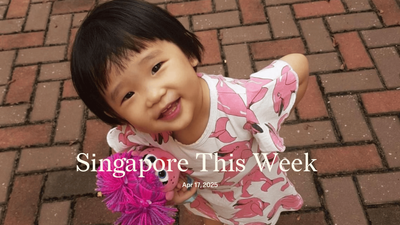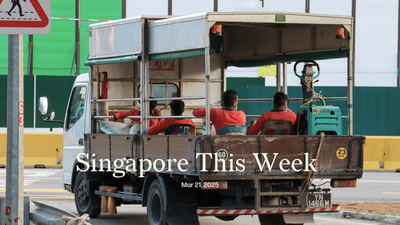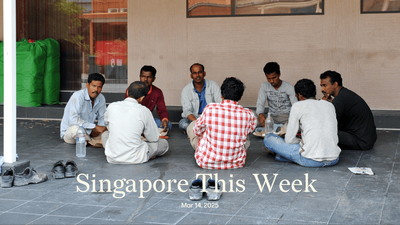Politics: What our love of Kissinger says about Singapore
An inspiration and mentor for many of us, cooed Vivian Balakrishnan, foreign minister, about Henry Kissinger, the former US secretary of state who just passed. As acute as ever, said Tharman Shanmugaratnam, president, about meeting the 99-year-old last year. Lee Hsien Loong, prime minister, called Kissinger a peerless diplomat, true statesman, and visionary of his time. Suling Lin, opinion editor at The Straits Times, said that he devoted his years to building bridges instead of walls, and dedicated his life to peace. Not even Joseph Chinyong Liow, comparative politics scholar, in a commentary titled, “How will Henry Kissinger be remembered in Southeast Asia?”, could muster direct words about the over 50,000 Cambodian civilians killed by Kissinger’s secret, carpet-bombing campaign in 1969-70—one that he authorised with chilling instructions to hit “anything that flies or anything that moves.” This earned Kissinger the label of “war criminal” from his numerous critics, though his sins, as the “ultimate practitioner of realpolitik pragmatism”, in Liow’s words, extend well beyond that. He supported Indonesia’s invasion of Timor Leste, Pinochet’s coup in Chile, and other right-wing dictatorships, all part of a relentless effort to stamp out socialism and communism in service of a Pax Americana led by the world’s cop and its multinationals. He turned a blind eye to Pakistan’s atrocities during Bangladesh’s war of independence—sneering “at people who ‘bleed’ for the ‘dying Bengalis’”, wrote scholar Gary Bass—because the former was helping the US snuggle up to China. (Their eventual rapprochement, in which Kissinger played a major role, is perhaps his greatest positive contribution to the world.) As adviser to Union Carbide, part of a glittering and lucrative post-government consulting business, Kissinger was instrumental in helping the company evade responsibility for the 1984 chemical disaster in Bhopal—what The Atlantic called “the world’s worst industrial accident”—partly by negotiating a paltry payout for victims, which Indians today continue to denounce. In the US, he had no compunction about wiretapping journalists and colleagues. The fear of a repeat of last century’s world wars is what compelled him, he told The Economist this April. The grand “peace” he sought would be achieved, in this worldview, through amoral realpolitik, in which: backroom dealings between powerful men dictate the swerves of history; the ends always justify the means; socialist ideals and ideas are dangerous; global capitalism is a force for good; and the accompanying stratified, classist labour structure is a basis for regarding some humans as worth more than others. No surprise that Lee Kuan Yew was a chum.
Society: Your ah ma is lonely
According to the World Health Organization, social isolation affects 25 percent of the elderly worldwide. In Singapore, this figure is much higher at 40 percent. While social isolation can be understood as a “lack of social, emotional and physical engagement”, loneliness is more subjective—it’s an indicator of a poor quality of interactions with others. “Loneliness and social isolation trigger complex biological pathways across multiple systems, like cardiovascular, nervous and hormone regulatory systems,” said Dr Arthi Premkumar, an associate consultant from the Healthy Ageing programme at Alexandra Hospital. Together, loneliness and isolation can have the same effect on the body as smoking, cardiovascular disease and low immunity, resulting in an overall increased risk of death. One might think that seniors who live alone are most vulnerable, but the reverse is true: the most socially disconnected individuals actually live with family members, according to Koh Woon Puay of the National University of Singapore. Koh studied 17,000 seniors aged 61 to 96 years, and found that four in five socially isolated seniors lived with their families, compared to three in 20 seniors living on their own. This is because “family restricted” seniors have limited access to support from extended members of the community, she explained. The study also found that men were twice as likely to be disconnected from their peers compared to women, due to smaller social networks given their traditional role as breadwinners. To address this issue, the government is cultivating various strategies that align with their A-B-C model: active ageing, befriending, and care in the community. They hope that the transformation of Active Ageing Centres into “magnets” for seniors to leave their homes, for example, will encourage more socialisation and physical activity among the elderly. One other possibility is to encourage more interaction in existing “third spaces”—locations separate from the home or workplace, such as cafes, parks and supermarkets. For example, a supermarket chain in the Netherlands introduced a “chat checkout”, or kletskassa, for elderly shoppers who want to spend more time conversing and interacting with staff. The kletskassa was received positively by both staff and customers of all ages, and is now being rolled out in 200 stores. Some stores even have an “All Together Coffee Corner” where locals can chat with neighbours and other members of the community. Perhaps Sheng Siong can consider a kletskassa of its own.
Society: HIV cases on the rise after lowest rate reported last year
HIV has killed an estimated 40.4m people since the epidemic first rampaged through the world in the 1980s. But despite concerted efforts to raise awareness and dispel myths about the disease, stigma persists, preventing people from insisting on condom use, getting routinely tested, or receiving the treatment they need. In 2022, 39m people were living with HIV globally, and AIDS claimed one life every minute. Still, there are lessons to be learnt about equity, justice, and discrimination. Amidst the suffering and loss are also countless stories “of activism, of rage and resilience, and of scientific triumph.” Medical investments and advances have meant that HIV/AIDS is no longer a death sentence. While not a cure, antiretroviral therapy, if taken regularly, is effective at controlling the infection. But the struggle isn’t over—1.3m people were newly infected last year. In Singapore, after three consecutive years of declining cases, the number of newly diagnosed HIV infections—188—in the first 10 months of this year rose by 10 percent, compared to the same period last year, as reported by the Ministry of Health on World AIDS Day. Of the 104 cases reported between January and June, almost all involved males infected through sexual intercourse. Sixty-eight percent of cases occurred in men who have sex with men (MSM), though in totality from 1985 to June 2023 heterosexual sex accounts for far more cases than MSM. UNAIDS is optimistic, however, that we can end AIDS by 2030. In its report “The Path that Ends AIDS”, it noted that strong political leadership was key, as seen in countries that have achieved the biggest progress. And also investing in a “sustainable response”, by financing “evidence-based HIV prevention and treatment, health systems integration, non-discriminatory laws, gender equality and empowered community networks.” The usual messages of remaining faithful and avoiding casual sex might no longer suffice. It’ll take more than just well-meaning advice to prevent cases like these from happening again: a male sex worker with HIV who had sex with various men without telling them; a part-time religious teacher who sexually abused underaged boys even after contracting HIV; and an HIV-positive man who donated blood after declaring false information.
History Weekly by Faris Joraimi
Last Tuesday, Tharman presided over the launch of a new book by the doyen of Chinese history in South-east Asia, Professor Wang Gungwu. Entitled, Living with Civilisations: Reflections on Southeast Asia’s Local and National Cultures, the book contains lectures he delivered at the Institute of Policy Studies between November last year and March this year, focusing on South-east Asia being influenced by four large civilisations: Sinic, Indic, Islamic, and Christian-European. I haven’t read the book, and I never attended any of the lectures. It’ll be interesting to see how Prof Wang reflects on the term and perhaps highlights its limitations, especially since historians in the last few decades have thought a lot about the intense cultural, social, and intellectual exchanges that have always existed between and within human societies and groups, and not just in South-east Asia. East Asia, South Asia, the Islamic world and Europe were intensely hybrid, multiethnic, multilingual, and were always changing, which complicates thinking about them in terms of distinct and stable units that “civilisation” typically implies. Are the standards attained by all “civilisations” even translatable across vastly diverse cultural and social formations over time and space? While many human societies have distinguished themselves as being different from “outsiders” in different ways for centuries, our popular notion of “civilisation” usually still sticks to a European idea that arose in the late-18th century Enlightenment. The view that South-east Asia (another problematic notion!) has no “indigenous civilisation” and was always a creative receptacle adapting external influences is a classic paradigm from orientalist scholarship, as if those doing the “influencing” were themselves never “influenced”. To top it off, Tharman in his speech held up Singapore as a product of this South-east Asian tradition of openness and tolerance, that the British left unchanged. These are grand assertions, which a lot of historical research has challenged. But by all means, read the book! Then read others, then think and argue.
Arts: Bearing witness through “The Gaza Monologues”
The horrific casualties from the ongoing bombardment of Gaza have prompted artists around the world to call for peace. Last week, three Singaporean arts groups and artists presented their versions of “The Gaza Monologues”, a series of 39 monologues first written and performed in 2010 by Gazan teenagers under the mentorship of Ashtar Theatre, a non-profit founded in Jerusalem in 1991. The taut, propulsive monologues are at their most devastating in their clear-eyed assessments of their young writers’ impending mortality. In one of them, a 16-year-old describes the slow dread of discovering his brother’s death. His eulogy pivots on a delicate fulcrum of heartbreak and humour—the way siblings can break our hearts and put us back together: “Since my brother was martyred I got used to sleeping in the bed alone. We used to sleep one on top of the other, legs on top of heads, sometimes it felt like all our limbs were jumbled together. But today I have a bed by myself! [pause] I’ll never forget my brother.” Later on, an 18-year-old writes about the aftershock of blacking out from a bomb on the first day of her exams: “The hardest thing to feel is that your moment of death is near.” Two versions of “The Gaza Monologues” are available as digital recordings: theatre development space Centre 42 collaborated with the popular “T42” podcast to produce a 90-minute podcast featuring artists such as Preeti Nair and Karen Tan. Musician bani haykal has also put together a 102-minute recording including the likes of Marylyn Tan, Singapore Literature Prize winner, and award-winning slam poet Stephanie Dogfoot Chan. The third rendition was a live Zoom reading organised by arts administrators from local theatre company Teater Ekamatra, acting in their personal capacities. During the marathon session, volunteer performers, reading to an online audience of almost 200, would often choke up while reading the translated scripts, voices catching and cracking as they attempted to capture the bloom of youth aborted by war. Shaza Ishak, one of the organisers, concluded the emotionally charged session by imploring the audience, just as the Palestinians she’d met in the Dheisheh Refugee Camp had 10 years ago: “Tell the world about us. Tell them we exist. Tell them we want to live.”
Arts: Two novelists and a choreographer receive Cultural Medallion
Writers Meira Chand and Suchen Christine Lim, as well as Malay dance guru Osman Abdul Hamid, are this year’s recipients of the Cultural Medallion, the state’s highest honour for artists conferred annually to practitioners nominated by the arts community. Osman, an athlete and footballer turned dancer-choreographer, has embraced cross-cultural and trans-genre experiments over the course of his four-decade career. Influenced by mentors such as the late Santha Bhaskar and Neila Sathyalingam, cornerstones of Indian classical dance, as well as intercultural dance exponent Goh Lay Kuan, Osman has has introduced silat and wushu vocabularies into the vernacular of classical Malay dance. Chand and Lim are known for their sweeping historical epics that explore Singapore’s past, and both indulge and interrogate the nation-state’s multiculturalist aspirations. London-born Chand has been described as bringing “an outsider’s acute eye” to Singapore, while Ipoh-born Lim is the insider transmuting personal ancestry into public history. Chand’s meticulously researched and critically acclaimed A Different Sky (2010) spans three decades in Singapore, from a Chinatown communist riot in 1927 to pro-independence rallies in 1957 Malaya. Lim’s Fistful of Colours (1993) attends to questions of ethnic identity and intercultural marriage through the inner world of a teacher and her pursuit of artistic freedom. The novel has been a mainstay on secondary and pre-tertiary literature rosters. The Cultural Medallion has been bestowed on over 130 artists since 1979, when it was first instituted by the late Ong Teng Cheong, then minister for culture. The award can act as a cultural legitimator, offering up a vision of Singaporean artistic practice that fits the socially engaged and multicultural ambit of the state—but can also offer some financial freedom, because it comes with a sizeable S$80,000 grant, which recipients have used for performances and publications. Previous recipients have included theatre director Ivan Heng, novelist Ho Minfong and the late composer Iskandar Ismail. In interviews with The Straits Times, Chand and Lim, who also happen to be good friends, expressed their disbelief at being nominated. Chand describes the pact they made: “Look, we’ll go forward hand in hand...if you get it, I’ll give you a big hug. And if I get it, you give me a hug.”
Tech: Grabbing first place for Malaysia’s digital bank
Having won the ride-hailing race in Malaysia, Grab is now the first to launch a digital bank there. GXBank, a subsidiary of the Singapore-based GXS Bank—a joint venture between Grab, Singtel, and a group of Malaysian investors, including the Kuok Group—commenced operations after its beta testing phase. GXBank is the first digital bank to receive a licence and start operating among five applicants in Malaysia. The digital bank offers daily interest rates of three percent per annum on savings in users’ primary accounts or their “Pockets” feature, a savings goal tool that is reportedly used by nearly 50 percent of beta testers. The platform also plans to roll out the GX Card, a debit card in partnership with Mastercard, but hasn’t specified a timeline. Leveraging the licence from Malaysia’s central bank, Bank Negara Malaysia, GXBank guarantees deposits up to 250,000 ringgit (around S$71,717) per user, with insurance provided by Perbadanan Insurans Deposit Malaysia. The success story of GXS Bank in Singapore, which saw nearly US$3m (S$4.08m) in deposits by the end of 2022, reflects a promising future for GXBank. This expansion includes an increase in its savings account deposit limit from S$5,000 to S$75,000 per account. Furthermore, the parent companies’ foothold in Indonesia, via their investment in the digital bank Superbank, foreshadows an expanding digital banking network in the region. It may be a matter of time before South-east Asia customers only need one digital bank account that can be used across multiple countries.
Tech: TikTok to consolidate in Indonesia’s e-commerce sector
TikTok, whose global headquarters is in Singapore, has seen five-fold growth in TikTok Shop users since October 2022. However, it has faced regulatory challenges across the region, and is actively seeking commercial deals to circumvent them, and thus preserve the platform’s dominance in the region. ByteDance, the Chinese owner of TikTok, is reportedly in the final stages of discussion with Tokopedia, the e-commerce division of Indonesian tech firm GoTo, for a partnership and investment deal, involving a 10-50 percent stake. The deal could see ByteDance picking up a minor stake in Tokopedia initially, and gradually upping it to a majority position, ostensibly to manage the e-commerce operations. This development comes after the Indonesian government banned social media platforms from engaging in e-commerce activities in September 2023, causing TikTok Shop to close down. Last week, Zulkifli Hasan, Indonesia’s minister of trade, denied claims made by his deputy Jerry Sambuga that TikTok is in the process of obtaining an e-commerce permit from the government. A partnership with Tokopedia could allow the platform to re-engage its Indonesian users more effectively, and may also lead to improved relations with the government by aligning more closely with local interests. With an estimated 119m users in Indonesia in 2022, this market is a major pivot point for TikTok’s global business plan. Given TikTok Shop’s projected regional market share of 13.9 percent for 2023, a successful partnership could significantly reshape the dynamics of competition in South-east Asia’s e-commerce market (notwithstanding some market scepticism about the deal). TikTok’s ability to successfully navigate the regulatory hurdles in Indonesia may offer some guidance for its business in Malaysia and Philippines, given that regulators there are also exploring greater regulation of the platform.
If you enjoy Jom’s work, do get a paid subscription today to support independent journalism in Singapore.








